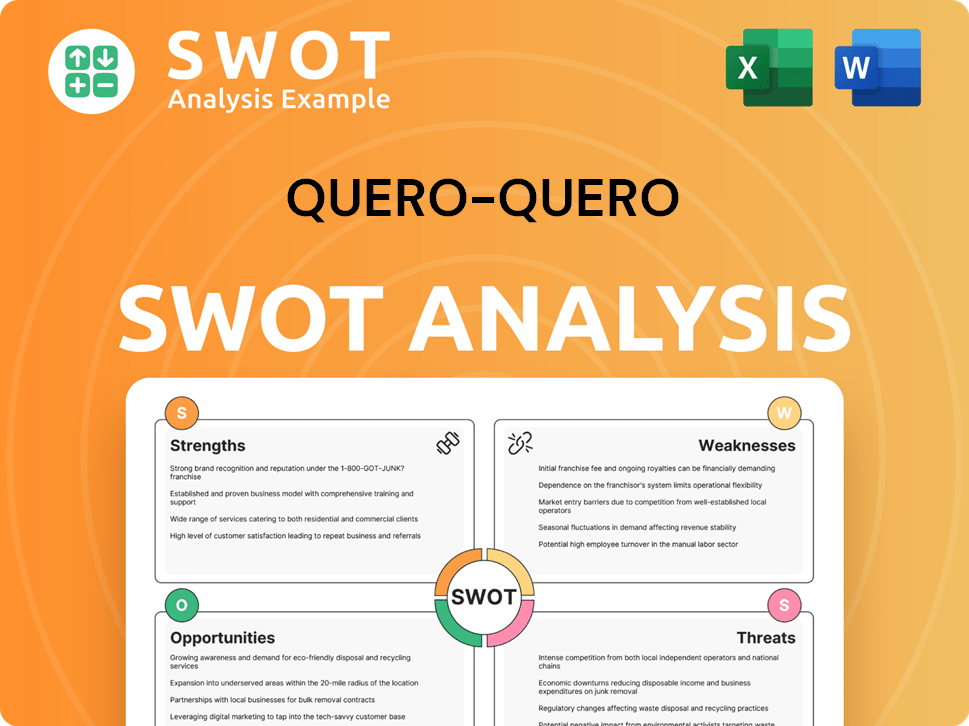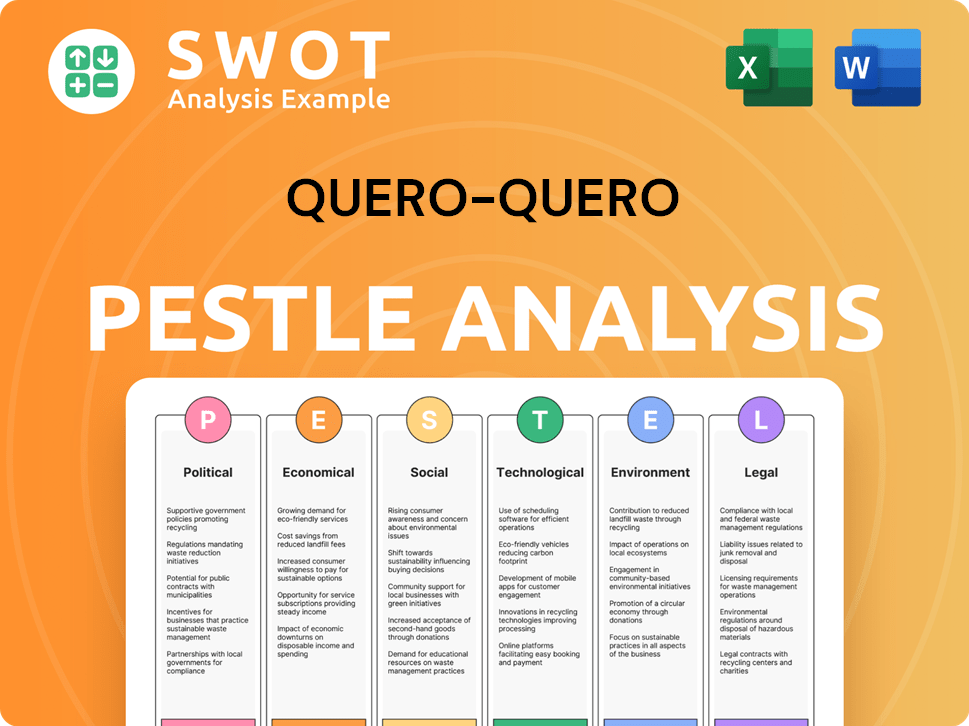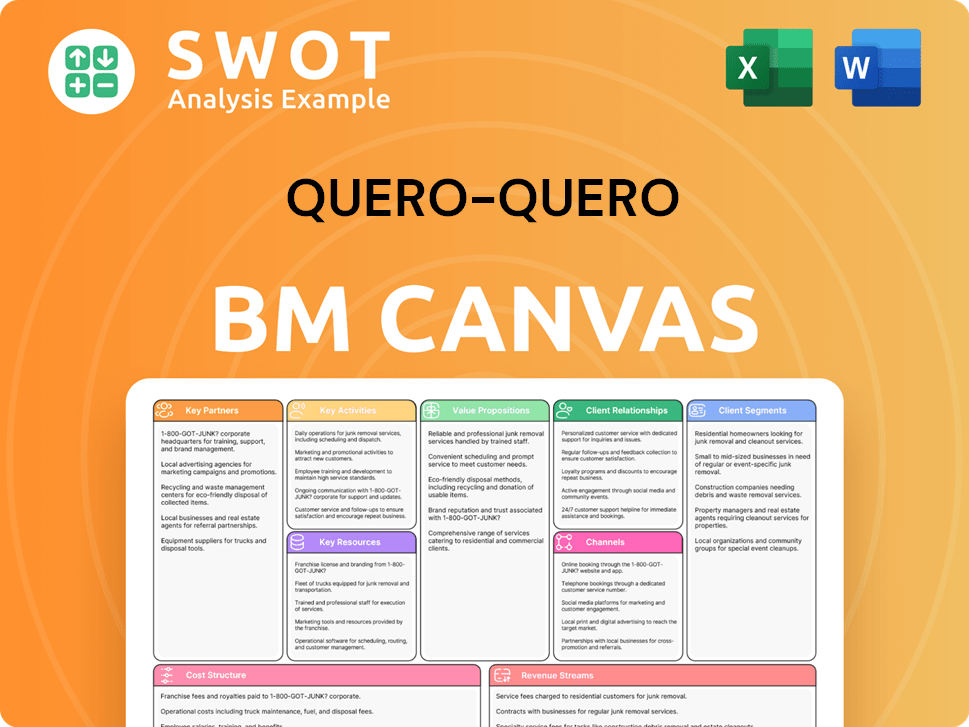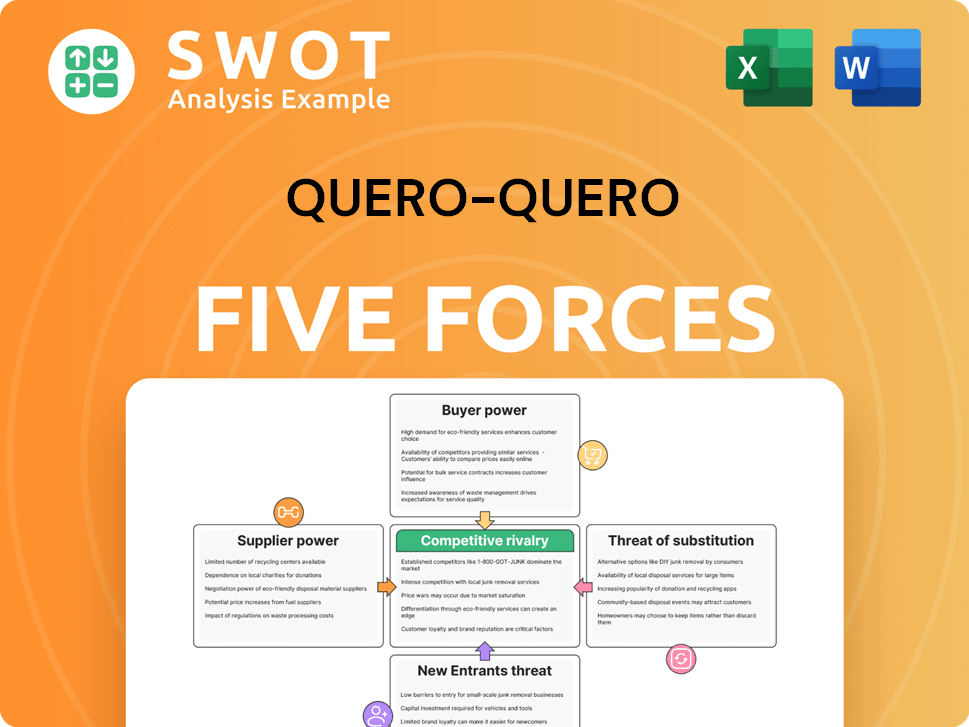Quero-Quero Bundle
Can Quero-Quero Thrive in Brazil's Retail Arena?
The Brazilian retail sector is a dynamic battlefield, and Lojas Quero-Quero is a key player. With the market projected to surge to USD 370.96 billion by 2034, understanding the Quero-Quero SWOT Analysis is crucial. This analysis dives deep into the company's competitive positioning.

This exploration of the Quero-Quero competitive landscape provides a comprehensive Quero-Quero market analysis, examining its position within the Quero-Quero industry. We'll dissect who Quero-Quero's main rivals are, evaluating their strategies and financial performance. Furthermore, we'll assess Quero-Quero's competitive advantages and growth potential within the Brazilian market, offering actionable insights for investors and strategists alike.
Where Does Quero-Quero’ Stand in the Current Market?
Lojas Quero-Quero holds a significant position within the Brazilian retail sector, specializing in construction materials, home appliances, and furniture. The company has established a strong presence, particularly in southern Brazil. As of the first quarter of 2025, the company operates a network of 576 stores, reflecting its commitment to expanding its physical footprint.
The company caters to both individual consumers and businesses, offering affordable options for home building, renovation, and furnishing. This approach is complemented by financial services through its VerdeCard credit cards, enhancing its integrated solution strategy. The company's focus on providing a comprehensive range of products and services positions it as a key player in the market.
The company's business model is designed to offer accessible and comprehensive solutions for its customers. This includes not only a wide variety of products but also financial services. For a deeper understanding of the target consumer base, consider exploring the Target Market of Quero-Quero.
Lojas Quero-Quero operates primarily in southern Brazil, with a strong presence in states like Rio Grande do Sul, Santa Catarina, and Paraná. The company's expansion strategy includes opening new stores to increase market penetration, especially in key regions.
The company offers a wide range of products, including construction materials, home appliances, and furniture. It also provides financial services through VerdeCard credit cards, aiming to offer integrated solutions for its customers.
For the full year ended December 31, 2024, the company reported a revenue of BRL 2,666.33 million. In Q1 2025, revenue was BRL 671.52 million, a 14% increase from Q1 2024. However, net income saw fluctuations, with a net loss of BRL 31.1 million in Q1 2025.
The VerdeCard credit card portfolio grew by 8.2% in its net portfolio with interest in Q1 2025 compared to Q1 2024. Transacted volume outside its stores grew by 30.4% in the same period, indicating increased card activation and usage.
Despite the net loss in Q1 2025, retail sales grew by 15.7%, and same-store sales (SSS) increased by 12.5%. This indicates strong sales performance, even with lower margins due to promotional activities and seasonal demand.
- The company's focus on expansion, with 8 new stores opened in Q1 2025.
- Strong growth in retail sales and same-store sales, despite fluctuations in net income.
- Increased card activation and usage of VerdeCard, contributing to integrated financial solutions.
- Continued efforts to enhance its market position in the competitive Brazilian retail landscape.
Quero-Quero SWOT Analysis
- Complete SWOT Breakdown
- Fully Customizable
- Editable in Excel & Word
- Professional Formatting
- Investor-Ready Format

Who Are the Main Competitors Challenging Quero-Quero?
The competitive landscape for Lojas Quero-Quero in Brazil's retail sector is multifaceted, involving both direct and indirect competitors. The company operates within a market that is significantly large, with the Brazilian retail market valued at USD 219.24 billion in 2024, offering a broad scope for competition and growth. Understanding the key players and their strategies is crucial for assessing Lojas Quero-Quero's position and potential in the market.
Direct competition comes from established retail chains specializing in home improvement, furniture, and appliances. These competitors often have extensive product ranges and established brand recognition. The competitive dynamics are also shaped by the ongoing shift towards modern retail formats and digital platforms, which is particularly pronounced in urban areas of Brazil.
Indirect competition also plays a significant role, with general retail giants and emerging e-commerce platforms vying for market share. The rise of e-commerce and social commerce in Brazil adds further complexity to the competitive environment. In this context, Lojas Quero-Quero must navigate the challenges posed by both traditional and digital competitors to maintain and enhance its market position. Read more about the Revenue Streams & Business Model of Quero-Quero.
Direct competitors include major retail chains that offer similar product portfolios. These rivals compete through pricing, product ranges, and brand recognition.
Indirect competition comes from general retail giants and emerging e-commerce platforms. The growth of online retail and social commerce intensifies the competitive dynamics.
The Brazilian retail market is adapting to shifting consumer preferences, with a significant transition towards modern retail formats and digital platforms. This includes increased digitization and e-commerce growth.
Online retail is gaining considerable ground, attracting investments from both domestic and international players. This shift means Lojas Quero-Quero also competes with online-only retailers and marketplaces.
The growth of social commerce in Brazil, projected to reach US$4.16 billion by 2025, further intensifies the competitive dynamics. Players like MercadoLibre and Shopee are expanding their services.
Mergers and alliances in the broader retail sector, such as Carrefour's acquisition of Atacadao in April 2024, impact the competitive environment. This strengthens market share.
The main competitors for Lojas Quero-Quero include Grupo Casas Bahia, Grazziotin, and Marisa Lojas. These companies employ various strategies to compete in the market.
- Pricing Strategies: Offering competitive prices and promotional discounts to attract customers.
- Product Range: Providing a wide variety of products to cater to diverse customer needs.
- Brand Recognition: Leveraging strong brand presence and customer loyalty.
- Digital Presence: Investing in e-commerce platforms and digital marketing to reach a broader audience.
- Market Expansion: Expanding store networks and distribution channels.
Quero-Quero PESTLE Analysis
- Covers All 6 PESTLE Categories
- No Research Needed – Save Hours of Work
- Built by Experts, Trusted by Consultants
- Instant Download, Ready to Use
- 100% Editable, Fully Customizable

What Gives Quero-Quero a Competitive Edge Over Its Rivals?
The Quero-Quero competitive landscape is shaped by its unique blend of retail offerings and strategic market positioning. The company's approach centers on providing integrated solutions, which includes construction materials, home appliances, and furniture. This strategy aims to meet a wide array of customer needs, fostering loyalty and potentially increasing transaction values within the Quero-Quero business model.
A key element of its strategy involves a strong physical presence, particularly in smaller cities across southern Brazil. As of Q1 2025, the company operates a significant number of stores, focusing on areas where it can enhance market penetration. This physical footprint allows it to serve customers who prefer in-person shopping or have limited access to larger retail centers, setting it apart in the Quero-Quero industry.
The company's financial services, especially its VerdeCard credit card, provide flexible payment options, potentially boosting purchasing power and encouraging repeat business. The VerdeCard's net portfolio with interest grew by 8.2% in Q1 2025 compared to Q1 2024, and the transacted volume outside of its stores increased by 30.4%, indicating growing customer activation and usage. This financial arm not only generates revenue but also enhances customer loyalty, which is a crucial aspect of Quero-Quero's competitive strategies.
The company's wide network of stores, especially in small and mid-sized towns, is a major advantage. This extensive physical presence enables it to cater to customer segments that may prefer in-person shopping. As of Q1 2025, the company operates 576 stores, strategically expanding into regions like Paraná.
The VerdeCard credit card offers flexible payment options, increasing customer purchasing power. This financial service boosts customer retention and generates additional revenue. The net portfolio with interest grew by 8.2% in Q1 2025 compared to Q1 2024.
The 'one-stop-shop' approach, featuring construction materials, home appliances, and furniture, increases customer loyalty. This comprehensive offering caters to a wide range of household and construction needs. This strategy helps to increase average transaction values.
The company has integrated digital sales, which accounted for 26% of total sales in Q1 2025. This digital presence optimizes inventory and expands sales channels. Adapting to digital trends is crucial for maintaining a competitive edge.
The company's competitive edge is built on its extensive store network, integrated financial services, and diverse product portfolio. These elements work together to create a strong market position, especially in the regions it serves. The company's long-standing history since 1967 and its focus on building relationships within small and medium-sized countryside communities contribute to a strong brand equity and customer trust in these regions, which is a key part of Quero-Quero market analysis.
- Extensive physical store network, particularly in southern Brazil.
- Integrated financial services, including the VerdeCard credit card.
- Diverse product offerings, including construction materials, appliances, and furniture.
- Adaptation to digital sales, accounting for 26% of total sales in Q1 2025.
Quero-Quero Business Model Canvas
- Complete 9-Block Business Model Canvas
- Effortlessly Communicate Your Business Strategy
- Investor-Ready BMC Format
- 100% Editable and Customizable
- Clear and Structured Layout

What Industry Trends Are Reshaping Quero-Quero’s Competitive Landscape?
The Brazilian retail sector is currently undergoing significant transformation, creating both challenges and opportunities for Lojas Quero-Quero. The company's ability to adapt to evolving consumer behaviors and economic fluctuations will be critical for maintaining its market position. Understanding the competitive landscape and the strategic moves of rivals is essential for Lojas Quero-Quero to sustain growth.
The Quero-Quero competitive landscape is shaped by digital advancements, economic volatility, and shifting consumer preferences. The company faces the need to enhance its e-commerce capabilities and adapt to changing market dynamics. Factors such as the company's financial performance and strategic decisions are critical for its future success.
Digital transformation and e-commerce growth are key trends. Social commerce is projected to reach US$4.16 billion by 2025. Fluctuating consumer spending patterns due to macroeconomic factors also impact the sector. The Brazilian retail market is projected to grow at a CAGR of 5.40% between 2025 and 2034.
Maintaining consistent growth and profitability amidst volatile consumer behavior is a significant challenge. High interest rates continue to pressure retail margins, which is expected to persist into Q2 2025. Competition from online retailers and the need to adapt to changing consumer preferences pose ongoing challenges for Lojas Quero-Quero.
Strategic expansion, such as opening new stores, presents growth opportunities. The integrated solution model, combining construction materials, home appliances, and financial services, helps capture a broad customer base. The company's conservative approach to credit and collections supports financial stability.
Enhancing digital sales channels and leveraging financial services are key strategies. Strategic store network expansion, particularly in regions with lower market penetration, is crucial. The company focuses on maintaining control over delinquency indicators. For more insights, see the Growth Strategy of Quero-Quero.
The company's digital sales accounted for 26% of total sales in Q1 2025. The furniture and household appliances segment saw a 2.8% decline in November 2024, with a 7.5% increase in October 2024, and a 0.4% fall in March 2025. The company opened 8 new stores in Q1 2025, showing a proactive expansion approach.
- Focus on e-commerce capabilities to meet evolving consumer preferences.
- Strategic expansion into regions with lower market penetration.
- Leveraging financial services to attract and retain customers.
- Maintaining control over delinquency indicators in a challenging economic climate.
Quero-Quero Porter's Five Forces Analysis
- Covers All 5 Competitive Forces in Detail
- Structured for Consultants, Students, and Founders
- 100% Editable in Microsoft Word & Excel
- Instant Digital Download – Use Immediately
- Compatible with Mac & PC – Fully Unlocked

Related Blogs
- What are Mission Vision & Core Values of Quero-Quero Company?
- What is Growth Strategy and Future Prospects of Quero-Quero Company?
- How Does Quero-Quero Company Work?
- What is Sales and Marketing Strategy of Quero-Quero Company?
- What is Brief History of Quero-Quero Company?
- Who Owns Quero-Quero Company?
- What is Customer Demographics and Target Market of Quero-Quero Company?
Disclaimer
All information, articles, and product details provided on this website are for general informational and educational purposes only. We do not claim any ownership over, nor do we intend to infringe upon, any trademarks, copyrights, logos, brand names, or other intellectual property mentioned or depicted on this site. Such intellectual property remains the property of its respective owners, and any references here are made solely for identification or informational purposes, without implying any affiliation, endorsement, or partnership.
We make no representations or warranties, express or implied, regarding the accuracy, completeness, or suitability of any content or products presented. Nothing on this website should be construed as legal, tax, investment, financial, medical, or other professional advice. In addition, no part of this site—including articles or product references—constitutes a solicitation, recommendation, endorsement, advertisement, or offer to buy or sell any securities, franchises, or other financial instruments, particularly in jurisdictions where such activity would be unlawful.
All content is of a general nature and may not address the specific circumstances of any individual or entity. It is not a substitute for professional advice or services. Any actions you take based on the information provided here are strictly at your own risk. You accept full responsibility for any decisions or outcomes arising from your use of this website and agree to release us from any liability in connection with your use of, or reliance upon, the content or products found herein.